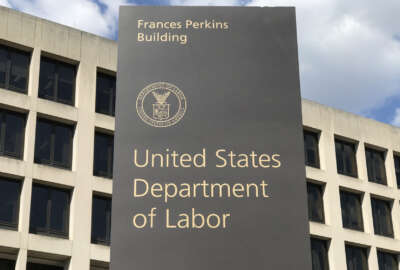Hubbard Radio Washington DC, LLC. All rights reserved. This website is not intended for users located within the European Economic Area.
This Labor Department advisor has been working disability issues for decades
Persistence and focus have paid off for one Labor Department policy advisor. His beat for 23 years of federal service has been access for people with disabiliti...
Persistence and focus have paid off for one Labor Department policy advisor. His beat for 23 years of federal service has been access for people with disabilities, access to transportation, jobs, and technology at the federal and state levels. For his work he’s a finalist in this year’s Service to America Medals program, Federal Drive with Tom Temin spoke with Supervisory Policy Advisor Michael Reardon.
Interview Transcript:
Tom Temin And tell us what has driven your focus, all of these many years, on this particular topic.
Michael Reardon So, I mean, I always had a tremendous interest in disability. I don’t have a disability myself, but as a policy area, I can’t think of one that’s more attractive not only to me, but in terms of state and local policymakers, federal policymakers, etc.. When you talk about people with disabilities getting jobs, it’s a win win for everyone. It’s a win win for the person with a disability, obviously, for their families and for the state and local levels who are otherwise would have to basically pay benefits to individuals who could otherwise be employed.
Tom Temin And if you go back 23 years to when you started in this work for the federal government, that was still a good 25 years after the Americans with Disabilities Act. And so you found still a lot of areas where work needed to be done?
Michael Reardon Yeah, absolutely. And not only where it needed to be done, but how it needed to be done. So just as an example, we’re a very small policy office. We have, in terms of federal government standards, we’re not very rich and we’re not very big. And so we employ a number of strategies in order to be able to hit above our weight. And so one of those strategies is what I call passing trains. So we look for those issue areas and those trends that are going to have a big impact on everyone, and try to jump in and add an employment and disability component to those trends. So we for instance, on technology, technology is here with us today. It’s going to expand every year for the foreseeable future. We want to make sure that future is an accessible, and an inclusive future for people with disabilities. So we work very closely with technology companies and technology associations, for instance, to make sure that what they do is accessible to everyone. And that benefits obviously people with disabilities in a number of ways, including their ability to get and maintain jobs.
Tom Temin Right? So as websites have become more complex to navigate and as technology gets more sophisticated, the advent of the smartphone, for example, came while you were doing your work. That’s the kind of thing where you got to make sure that those developments take accessibility along with them.
Michael Reardon Yeah, exactly right. So when we started, we have an initiative called the Partnership Unemployment and Accessible Technology, or PEAT. And we started in the realm of information and communication technology. Technology use on the job and at home, the technology that we’re using right now as we speak to each other. And we wanted to make sure that was not inadvertently inaccessible to people who have vision disabilities or cognitive disabilities, etc.. And what we found is the tech companies were incredibly responsive to that. And just to give one small example. At one time, Oracle, which is a huge tech company that owned about 80% of the market share for online job application software, a lot of their technology was inaccessible. So if you had a vision disability, for instance, the text that you were going through wasn’t necessarily lined up with the text that other people saw on paper, or if you had a physical disability, you might be inadvertently timed out because it took you longer to get through the process. Once Oracle was made aware by us of those issues, what was inaccessible technology to really thousands, if not millions of people all of a sudden became accessible. And so it greatly increases the likelihood that a person with a disability was able to get through that initial process that is not seen by a human being, it’s computer generated so that they weren’t inadvertently, again, excluded from job opportunities. Now, with the advent of artificial intelligence and machine learning and virtual reality, we’re in the realm of emerging technologies and we want to make sure that those technologies, again, don’t inadvertently exclude people with disabilities because people with disabilities, for instance, aren’t a part of the data sets that are used in the artificial intelligence. And so we’re working with a different set of technology companies and associations to start addressing those areas.
Tom Temin We’re speaking with Michael Reardon. He’s a supervisory policy advisor at the Labor Department and a finalist in this year’s Service to America Metals Program. Now, technology, very often as a matter accessibility is a matter of just programing and software and that little bit of effort, they can do a lot. What about transportation architecture? Some of those areas where the physical manifestation is expensive and difficult to re-engineer or rebuild for access. How have you found that over the years?
Michael Reardon Right. And that’s another actually great example of the work that I think we do as a small agency to try to influence our richer and bigger brothers and sisters. So we work very closely with the Department of Transportation in making sure that the programs that they develop, including a lot of the new programs that are developed under all of this infrastructure money coming out are accessible to people with disability and inclusive of jobseekers with disabilities. So we have developed a couple of different, there are a lot of acronyms, obviously, in the federal government, we have our share. But something called United We Ride, UWR, in which we have been able to work with the Department of Transportation, and they developed new programs that were more inclusive of people with disabilities seeking employment at the local level. So making sure that all the busses and the subway platforms and the railway platforms are accessible, and that the job market that’s coming out of the new infrastructure programs are inclusive of people with disabilities.
Michael Reardon So we want to make sure that any new mega transit program is inclusive of people of color, people of different ethnic backgrounds, but also inclusive of people with disabilities. And to do that, you have to focus on people with disabilities as job seekers and also make sure that what you’re doing is inclusive, both electronically and physically. And so that Department of Transportation, for instance, has a big project right now to make subway platforms accessible, and we’re very much involved with that to making sure that those programs are inclusive of people with disabilities, and some of the people that are advising them on that are people with disabilities. Another really quick example is on autonomous vehicles. Obviously, autonomous vehicles are on their way, they’re not here yet to a large extent. But we want to make sure that when they are, that the cars themselves are accessible to not just people with physical disabilities, but sensory disabilities, cognitive disabilities. And that the infrastructure around those cars that are also accessible. So where you pick up that autonomous vehicle, that site is accessible, and a person with a vision disability, for instance, would know how and when to get into the car and to do it safely.
Tom Temin Sure. Just wanted to point out with the subway accessibility issue, the platforms aren’t bad. It’s getting to the platforms half the time that is the issue, correct?
Michael Reardon Yes, absolutely. It depends on the city too. Chicago has many more issues, because their system is older than Washington, D.C., for instance. But you’re right, if you can’t get down to the platform or up to the platform, it doesn’t matter how accessible the rest of your system is. It has to all work together.
Tom Temin You mind the gap when you can get to the gap. And over the years, would you say the aperture has widened to what types of disabilities can be countered and made accessible? I think early on it was simply assumed people that had mobility issues, say wheelchair bound people, this kind of thing. But now we’re talking about different wide range of disabilities for people that nevertheless have abilities to contribute.
Michael Reardon Yeah, that’s an excellent point. A lot of people get visions in their minds when you talk about certain groups of people, and when you talk about a person with a disability, the vision most people probably get in mind is a person in a wheelchair. There are a lot of people who use wheelchairs in the United States who have disabilities, obviously. But there are a lot more who don’t. You can have a cognitive disability, you can have mental health related issues, you could have sensory disabilities, blindness and deafness. You can have neurological disabilities, it runs the gamut. We constantly talk to employers and what they forget sometimes. When we talk about hiring people with disabilities and supporting and promoting people with disabilities, they often forget that a lot of people that they were already employing have disabilities. They just may not be aware of it or don’t think of it in those terms. So if you have a mental health disability or a substance abuse disability, you still have a disability. And so it’s a very broad spectrum of the population. For Americans alone, it’s around 50 million people.
Tom Temin And I’m going to speak a little out of school here. Recently you had a broken leg, and so we’re rendered on crutches and so forth for a while. It must have been gratifying to understand personally how the work you’ve done manifests itself in daily life.
Michael Reardon Yes. Actually, it is interesting, given that I’ve been doing this for more than 25 years. And a lot of the systems that we’re trying to make accessible, it’s nice in some ways to see that they are or when you travel overseas to take the trip to see what the United States has done in terms of accessibility versus some of the other countries. Mostly good, in some cases, we’re not as advanced. But you do get a perspective of what it’s like to live that way for a very brief time. And I’m not equating my life at all to someone who has to deal with that on an ongoing basis. But you do get an appreciation for how complicated it is when you talk about trying to get a job and getting that job, and once you get that job, getting up in the morning and getting to the job, being able to use the equipment while you’re on the job. It’s like a house of cards for a lot of people with disabilities. They don’t need a lot, but if you take one of those cards away, and it could be access to child care or access to personal assistance or access to transportation or access to technology, then it all comes tumbling down. And so that’s why it’s a constant look at how do we remove barriers to employment that a lot of us take for granted. But for some people with disabilities, add that extra layer of complication.
Copyright © 2024 Federal News Network. All rights reserved. This website is not intended for users located within the European Economic Area.
Tom Temin
Tom Temin is host of the Federal Drive and has been providing insight on federal technology and management issues for more than 30 years.
Follow @tteminWFED





